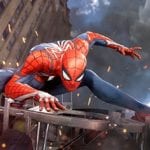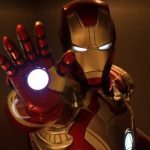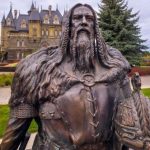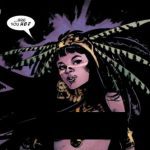 Technology
Technology  Technology
Technology  Humans
Humans 10 Everyday Human Behaviors That Are Actually Survival Instincts
 Animals
Animals 10 Animals That Humiliated and Harmed Historical Leaders
 History
History 10 Most Influential Protests in Modern History
 Creepy
Creepy 10 More Representations of Death from Myth, Legend, and Folktale
 Technology
Technology 10 Scientific Breakthroughs of 2025 That’ll Change Everything
 Our World
Our World 10 Ways Icelandic Culture Makes Other Countries Look Boring
 Misconceptions
Misconceptions 10 Common Misconceptions About the Victorian Era
 Mysteries
Mysteries 10 Strange Unexplained Mysteries of 2025
 Miscellaneous
Miscellaneous 10 of History’s Most Bell-Ringing Finishing Moves
 Technology
Technology Top 10 Everyday Tech Buzzwords That Hide a Darker Past
 Humans
Humans 10 Everyday Human Behaviors That Are Actually Survival Instincts
 Animals
Animals 10 Animals That Humiliated and Harmed Historical Leaders
Who's Behind Listverse?

Jamie Frater
Head Editor
Jamie founded Listverse due to an insatiable desire to share fascinating, obscure, and bizarre facts. He has been a guest speaker on numerous national radio and television stations and is a five time published author.
More About Us History
History 10 Most Influential Protests in Modern History
 Creepy
Creepy 10 More Representations of Death from Myth, Legend, and Folktale
 Technology
Technology 10 Scientific Breakthroughs of 2025 That’ll Change Everything
 Our World
Our World 10 Ways Icelandic Culture Makes Other Countries Look Boring
 Misconceptions
Misconceptions 10 Common Misconceptions About the Victorian Era
 Mysteries
Mysteries 10 Strange Unexplained Mysteries of 2025
 Miscellaneous
Miscellaneous 10 of History’s Most Bell-Ringing Finishing Moves
10 Great Comic Book Castings Wasted on Bad Scripts
Casting comic book characters onto the big (or small) screen is tricky. Unlike regular novels, these superpowered stories come with vivid illustrations of every plot beat. As such, fans have clear pictures of how the characters should look and act. Maybe that’s why they scrutinize these adaptations so closely. It’s painfully apparent when the wrong person lands a pivotal part, but it’s also rewarding when the role goes to the right star. As important as that aspect is, though, it’s not the only thing to consider.
Comic book adaptations could have phenomenal casting, but these perfect picks fall apart when the rest of the film can’t support them. Such cases arguably hurt more than a complete failure. As the stars step seamlessly into their characters’ shoes, they practically leap off the page with authenticity. They might even show a new side to an old favorite. An uninspired story then utterly wastes those efforts, forever tainting a promising legacy. Fans can’t help but wish these picks got the scripts they deserve. At least they make these turkeys more watchable.
Related: 10 Iconic Superhero Hallmarks That Didn’t Originate in Comics
10 Kelsey Grammer as Beast
The original X-Men movies are full of knockout casting choices, and Kelsey Grammer is one of them. He debuts as Hank McCoy/Beast in X-Men: The Last Stand (2006). The burly blue hero is an imposing sight, but his scientific background gives him an incredibly articulate demeanor. Grammer’s vocal precision conveys the character’s classiness. At the same time, his physical presence makes him the imposing figure you’d expect. He fits right in with the likes of Hugh Jackman as Wolverine and Famke Janssen as Jean Grey. Those guys have more to work with, though.
X-Men: The Last Stand is a mess. It tries to weave the Dark Phoenix plot into a mutant cure narrative, but this misguided mix pulls the film in opposing directions. Longstanding characters meet unceremonious ends as a result. Meanwhile, the survivors act so out of character that they cheapen their prior development. Rarely do so many moving parts yield so little.[1]
9 Melissa Benoist as Supergirl
Supergirl differs depending on the writer. She can be a sullen outcast from a doomed world or become an upbeat bundle of energy with a passion for heroism. The Supergirl (2015) TV series mainly subscribes to the latter camp, finding the ideal actress in Melissa Benoist. Her infectious zeal lets her easily command the screen. More importantly, she has such a believable purity that you can’t help but root for her. What’s most impressive of all is her ability to stomach this material.
The show often forgoes superhero adventures in favor of politics and romance. Most episodes deal with repetitive relationship woes, which unfold with vomitous melodrama rivaling the most soapy CW series. Worse, they feed directly into reductive takes on current events. The writers delight in referencing topical headlines about immigration, feminism, racism, gun control, and the trans movement. Not only are these issues forced, but the show handles them in such a shallow, one-sided way that it borders on propaganda. How it runs for five seasons is a question more elusive than Supergirl’s origin.[2]
8 Gal Gadot as Wonder Woman
Playing an Amazon is no easy feat, but Gal Gadot makes it look easy. She dons the armor of Wonder Woman in the DC Extended Universe. Though not as big as expected, she nevertheless excels in action, embodying the heroine’s warrior side through an almost primal body language. Her deep voice obviously helps in that respect, but it also aids in her sultry charm, which suits the character’s playful charisma. Her casting is one of the few good decisions in this cinematic universe.
The DCEU mainly consists of misfires. Wonder Woman’s immortality means she appears in many of them, much to her detriment. She’s there for the pretentious disaster of Batman v Superman: Dawn of Justice (2016), both versions of the lackluster Justice League (2017/2021), the pitifully silly Wonder Woman 1984 (2020), the brainless Shazam: Fury of the Gods (2023), and the uninspired buffoonery of The Flash (2023). The only positive example is her first solo film, Wonder Woman (2017), but even that devolves into CG nonsense during the third act. Thus, Gadot has the thankless task of bridging these foolish fiascos.[3]
7 Dina Meyer as Oracle
Plenty of heroes find strength through tragedy; Barbara Gordon is no exception. Originally fighting crime as Batgirl, a paralyzing shot through the spine confines her to a wheelchair. Thankfully, she uses her computer wizardry to continue the crusade, offering vital intel to superheroes as Oracle. The only actress who does justice to that journey (in live action, at least) is Dina Meyer. Her nuances work in tandem with her age to depict a seasoned heroine, yet she maintains the youthful spark that drives her to fight crime. The catch is that her portrayal is the lone bright spot.
Meyer is stuck in Birds of Prey (2002), a series about the female crime-fighting team. While compelling in concept, the show is a shallow product of its time. It subscribes to the school of navel-gazing teen angst prevalent during this period. The writers rely on this pseudo-edginess in lieu of genuine drama, so the characters, plots, and themes are paper-thin. On top of making the series a chore to watch, this masquerade means that Meyer can’t show the world why she’s right for this role.[4]
6 Ioan Gruffudd, Michael Chiklis, and Chris Evans as the Fantastic Four
The Fantastic Four presents a huge casting challenge. Not only must each actor be right for his/her role, but they must all have familial chemistry. After all, this superhero team is a family, first and foremost.
You truly feel that bond in Fantastic Four (2005) and Fantastic Four: Rise of the Silver Surfer (2007). Ioan Gruffudd exudes professorial intelligence as Reed Richards, and Michael Chiklis has both the blue-collar persona and the bulky physicality of Ben Grimm. Similarly, Chris Evans fits Johnny Storm’s frat-boy immaturity better than he ever did as Captain America. The outlier is Jessica Alba, who’s too young to be Sue Storm. Regardless, she and her costars still gel into a convincing family unit, albeit one made of misfits. That’s where the problems start as well.
These movies are astoundingly stupid. The script routinely plays up the characters’ powers for cheap jokes. The screwball antics are straight out of a 2000s comedy, often overshadowing the actual story. Because of that, the rare dramatic moments don’t feel earned but rather obligatory. The kicker is that these blunders are still better than the other Fantastic Four flicks.[5]
5 Thomas Haden Church as Sandman
Flint Marko has a checkered history, both in-universe and in a meta sense. He starts as a shallow supervillain named Sandman, but subsequent glimpses into his unhappy upbringing set him on a path to redemption, turning him into an antihero. Thomas Haden Church imbues that journey with due empathy. Sure, he has a hardened criminal’s muscular build and chiseled features, but his eyes betray such crushing sadness that it’s hard not to pity him. It’s safe to say he does most of the heavy lifting.
Church debuts in Spider-Man 3 (2007). This threequel clearly has too many cooks in the kitchen. The most obvious clue is the surplus of villains, all fighting for screen time in a scattershot plot. The consequential contrivances mean the character drama isn’t as organic as previous outings, evidenced by retroactively tying Marko to the death of Spider-Man’s uncle. Given the shoddy foundation, Flint’s pathos is more unsteady than a sandcastle.[6]
4 Mark Strong as Sinestro
Green Lantern’s most iconic enemy ironically starts on the same team. Originally one of the emerald heroes, Sinestro’s brutality leads him down the villainous path of the Yellow Lanterns. Mark Strong is no stranger to such villainy, having portrayed numerous antagonists in his career. He easily brings that same darkness to Sinestro, but what’s striking is how he reigns it in. His natural intensity works equally well at conveying the driven discipline of a seasoned space cop. It’s just a shame he never goes on his pivotal journey.
Green Lantern (2011) is notorious for wasted potential. It repeats the mistake of several superhero blockbusters by trying to do too much within its limited time. On top of telling Hal Jordan’s Green Lantern origin, it throws in Parallax, Hector Hammond, and even Amanda Waller. This underdeveloped jumble leaves Sinestro with virtually nothing to do. Granted, he randomly finds a Yellow Lantern ring in a post-credits scene, but this shallow tease is only a reminder of what could have been.[7]
3 Anson Mount & Serinda Swan as Black Bolt & Medusa
The Inhumans are among the weirder inclusions in the Marvel pantheon. A royal family of genetically enhanced super beings, these guys live in a secret society on the Moon. Finding the right people to play them is a tall order, but Anson Mount as Black Bolt and Serinda Swan as Medusa are a good start. His expressive eyes and commanding charisma instill a surprisingly vivid personality into the silent ruler, and she carries an alluring mystique and regal authority as the long-haired queen. They even convey a convincing chemistry with minimal dialogue. Not speaking is a blessing in disguise here.
Inhumans (2017) is a contender for Marvel’s worst show. The writers don’t know how to humanize their godlike protagonists, so their predictable solution is to deprive the royals of their powers and positions. Though conveniently lessening the special effects, this cliched tactic still fails to endear the heroes to audiences. Everyone here is an obnoxious elitist. The best chemistry in the world can’t fix that problem.[8]
2 Eric Bana as The Hulk
Despite becoming a joke character in the mainstream, the Hulk is a grim figure in the Marvel Universe. Bruce Banner’s abusive childhood breeds deep-seated emotional issues. Although he tries to hide that trauma with scientific brilliance, it boils to the surface upon gaining a monstrous gamma transformation. Eric Bana is the most accurate portrayal in that respect. He obviously plays the introverted scientist with a wounded quality. Even in his quietest moments, however, he doesn’t seem entirely stable. You get the sense that he could snap at any moment, which is exactly the unease that Banner should inspire. Unfortunately, the movie doesn’t know what to do with him.
Hulk (2003) is an intriguing experiment, but it doesn’t pay off. It wants to be a thoughtful piece about how a man’s tragic upbringing comes back to haunt him. Then again, it frequently dilutes that goal with oddball choices like comic book panels and cartoonish bad guys. The final product feels painfully uneven because of these elements. Consequently, any dramatic conclusions it reaches are only surface level. That result is particularly disappointing for the most daring Hulk flick.[9]
1 Val Kilmer as Batman
Numerous actors have taken a stab at Batman, the tones varying from lighthearted to dour. One of the more underappreciated attempts comes from Val Kilmer. He plays it straight, his steely seriousness and whispered voice matching the hero’s ironclad resolve. In addition, Kilmer has a naturally unnerving hint of darkness about him. While this quality normally helps him play villains and killers, it also fits the tortured hero like a glove. Sadly, the movie doesn’t go that route.
Kilmer dons the cape and cowl for Batman Forever (1995). This flick echoes the flamboyant comics of yesteryear, but it also feels obligated to acknowledge the Dark Knight’s tragic roots. The subsequent adventure is a flashy, neon nightmare where two tones fight for dominance, ultimately satisfying neither side. Kilmer suffers because of it. As hard as he tries, the poor guy must continually undermine his own efforts through corny lines, cheesy smirks, and flat exchanges with his caricature costars. It’s no wonder he was “difficult” on set.[10]








